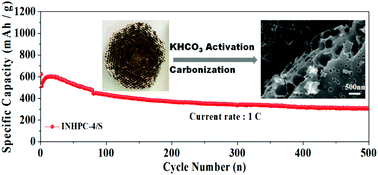Waste-honeycomb-derived in situ N-doped Hierarchical porous carbon as sulfur host in lithium–sulfur battery†
Abstract
Promising applications of lithium–sulfur batteries with high theoretical capacity are still severely limited due to the poor conductivity of sulfur, the polysulfide shuttle effect and volume expansion. Herein, low-cost and carbon/nitrogen-rich waste honeycombs are used to prepare in situ N-doped hierarchical porous carbon (INHPC) and firstly applied as a sulfur host by facile high-temperature carbonization combined with KHCO3 activation. The influence of mass ratios of the activator to honeycomb on the morphology and pore structure of the as-prepared carbon materials was investigated in detail. Among them, the optimized INHPC with a mass ratio of 4 : 1 presents block-like morphology with interconnected pore structure, while showing a high specific surface area of 1683.6 m2 g−1 and a large pore volume of 0.974 cm3 g−1. Moreover, the in situ N-doped carbon materials not only have good electronic conductivity but also strong chemical adsorption with polysulfide intermediates, hence effectively alleviating the shuttle effect. When used as the sulfur host, the as-obtained INHPC-4/S composite cathode with a sulfur content of 60 wt% delivers a high initial discharge capacity of 913.4 mA h g−1 and retains a reversible capacity of 538.3 mA h g−1 after 200 cycles at 0.2 C. Even at a current rate of 1 C, the first discharge capacity of 623.2 mA h g−1 can be obtained, simultaneously achieving the durable cycle life up to 500 cycles. These good electrochemical performances are ascribed to physicochemical synergistic adsorption of in situ N-doping and hierarchical porous structure as well as high ionic/electronic conductivity.



 Please wait while we load your content...
Please wait while we load your content...